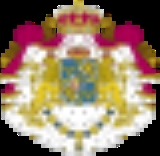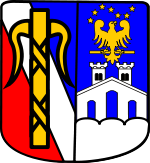
Coat of arms of Sweden
Encyclopedia
The greater national coat of arms (stora riksvapnet) and the lesser national coat of arms (lilla riksvapnet) are the official coats of arms
of Sweden
.
on the main escutcheon (two coats of arms duplicated), and three coat of arms incorporated into a escutcheon of pretense. However, Bernadotte never used any stars in the arms of Pontecorvo (neither as Prince of Pontecorvo, nor as King of Sweden and Norway) contrary to the illustration below. The stars were introduced as an element in the royal coat of arms in mid 19th century and then above the eagle.
, with the alterations and additions decided by him.
Blazon
: "The greater state arms consist of a head shield azure, quartered by a cross or with outbent arms, and an inescutcheon containing the dynastic arms of the Royal House.
In the first and fourth fields three coronets or, placed two above one. In the second and third fields three sinisterbendwise streams argent, a lion crowned with an open crown or with armaments gules. The inescutcheon is party per pale the arms for the House of Vasa
and the House of Bernadotte
. The main shield is crowned by a royal crown and surrounded by the insignia of the Order of the Seraphim
. Supported by two lions regardant or crowned, with parted tails and armaments gules, standing on a postament. All surrounded by hermine mantling crowned with a royal crown and tied up with tasseled strings or."
 The Personal Command Sign of H.M. the King of Sweden was introduced by a Royal regulation in 1943. The Command sign includes the central part of the greater coat of arms. The banner, officially termed His Majesty's Personal Command Banner, is one of a kind. The only copy was created by Einar Kedja, a renowned Swedish heraldic artist. The cloth is permanently attached to a pole with a crown serving as finial.
The Personal Command Sign of H.M. the King of Sweden was introduced by a Royal regulation in 1943. The Command sign includes the central part of the greater coat of arms. The banner, officially termed His Majesty's Personal Command Banner, is one of a kind. The only copy was created by Einar Kedja, a renowned Swedish heraldic artist. The cloth is permanently attached to a pole with a crown serving as finial.
and its agencies. As such it may be joined by insignias symbolising their activity, following approval by the State Board of Heraldry. It is, for instance, embroidered on all Swedish police uniforms.
Blazon: "Azure, with three coronets Or, ordered two above one." Crowned with a royal crown. The shield may also be surrounded by the insignias of the Order of the Seraphim
."
Any representation consisting of three crowns ordered two above one are considered to be the lesser coat of arms, and its usage is therefore restricted by law 1970:498.
Coat of arms
A coat of arms is a unique heraldic design on a shield or escutcheon or on a surcoat or tabard used to cover and protect armour and to identify the wearer. Thus the term is often stated as "coat-armour", because it was anciently displayed on the front of a coat of cloth...
of Sweden
Sweden
Sweden , officially the Kingdom of Sweden , is a Nordic country on the Scandinavian Peninsula in Northern Europe. Sweden borders with Norway and Finland and is connected to Denmark by a bridge-tunnel across the Öresund....
.
Escutcheon
The escutcheon used in the greater blazon has in total five elements: 4 quarteringsQuartering (heraldry)
Quartering in heraldry is a method of joining several different coats of arms together in one shield by dividing the shield into equal parts and placing different coats of arms in each division....
on the main escutcheon (two coats of arms duplicated), and three coat of arms incorporated into a escutcheon of pretense. However, Bernadotte never used any stars in the arms of Pontecorvo (neither as Prince of Pontecorvo, nor as King of Sweden and Norway) contrary to the illustration below. The stars were introduced as an element in the royal coat of arms in mid 19th century and then above the eagle.
| ↗ | ↗ | ↖ | |
| The three crowns Three Crowns Three Crowns is a national emblem of Sweden, present in the Coat of Arms of the Realm of Sweden, and composed by three yellow or gilded coronets ordered two above and one below, placed on a blue background.... |
Coat of arms of the House of Bjelbo House of Bjelbo The House of Bjelbo , also known as the House of Folkung , was an Ostrogothian Swedish family that provided for several medieval Swedish bishops, jarls and kings.- Name and origin :... |
 Coat of arms of the House of Bernadotte |
|
| ↗ | ↖ | ||
| Coat of arms of the House of Vasa House of Vasa The House of Vasa was the Royal House of Sweden 1523-1654 and of Poland 1587-1668. It originated from a noble family in Uppland of which several members had high offices during the 15th century.... |
The initial coat of arms of the Jean-Baptiste Jules Bernadotte Charles XIV John of Sweden Charles XIV & III John, also Carl John, Swedish and Norwegian: Karl Johan was King of Sweden and King of Norway from 1818 until his death... , Prince de Ponte Corvo, Maréchal de France (later King Charles XIV John of Sweden) |
||
| ↑ Standard quartering for the sovereign princes under the Napoleon I Napoleon I of France Napoleon Bonaparte was a French military and political leader during the latter stages of the French Revolution.As Napoleon I, he was Emperor of the French from 1804 to 1815... of the First French Empire First French Empire The First French Empire , also known as the Greater French Empire or Napoleonic Empire, was the empire of Napoleon I of France... . |
|||
| ↑ Eagle emblem of Napoleon I Napoleon I of France Napoleon Bonaparte was a French military and political leader during the latter stages of the French Revolution.As Napoleon I, he was Emperor of the French from 1804 to 1815... |
|||
Supporters
The arms are supported by two lions with forked tails (queue fourchée), facing away from the shield and crowned with Royal Crowns. For centuries, the lion has been an important element in Swedish heraldry and especially for the State Coat of Arms.Collars of the Royal Orders
The shield may be surmounted by the Collar of the Order of Seraphim, the foremost order in Sweden, and the highest honour the Swedish state can bestow on an individual.General description
Besides being the official national coat of arms, the greater coat of arms is also the personal coat of arms of the king, and as such he can decree its use as a personal coat of arms by other members of the Royal HouseBernadotte
The House of Bernadotte, the current royal house of Sweden, has reigned since 1818. Between 1818 and 1905, it was also the royal house of the Norway...
, with the alterations and additions decided by him.
Blazon
Blazon
In heraldry and heraldic vexillology, a blazon is a formal description of a coat of arms, flag or similar emblem, from which the reader can reconstruct the appropriate image...
: "The greater state arms consist of a head shield azure, quartered by a cross or with outbent arms, and an inescutcheon containing the dynastic arms of the Royal House.
In the first and fourth fields three coronets or, placed two above one. In the second and third fields three sinisterbendwise streams argent, a lion crowned with an open crown or with armaments gules. The inescutcheon is party per pale the arms for the House of Vasa
House of Vasa
The House of Vasa was the Royal House of Sweden 1523-1654 and of Poland 1587-1668. It originated from a noble family in Uppland of which several members had high offices during the 15th century....
and the House of Bernadotte
Bernadotte
The House of Bernadotte, the current royal house of Sweden, has reigned since 1818. Between 1818 and 1905, it was also the royal house of the Norway...
. The main shield is crowned by a royal crown and surrounded by the insignia of the Order of the Seraphim
Order of the Seraphim
The Royal Order of the Seraphim is a Swedish Royal order of chivalry created by King Frederick I of Sweden on 23 February 1748, together with the Order of the Sword and the Order of the Polar Star...
. Supported by two lions regardant or crowned, with parted tails and armaments gules, standing on a postament. All surrounded by hermine mantling crowned with a royal crown and tied up with tasseled strings or."
Personal Command Sign of H.M. the King

The lesser coat of arms
The lesser coat of arms is mainly used by the Government of SwedenGovernment of Sweden
The Government of the Kingdom of Sweden is the supreme executive authority of Sweden. It consists of the Prime Minister and cabinet ministers appointed by the Prime Minister. The Government is responsible for their actions to the Riksdag, which is the legislative assembly...
and its agencies. As such it may be joined by insignias symbolising their activity, following approval by the State Board of Heraldry. It is, for instance, embroidered on all Swedish police uniforms.
Blazon: "Azure, with three coronets Or, ordered two above one." Crowned with a royal crown. The shield may also be surrounded by the insignias of the Order of the Seraphim
Order of the Seraphim
The Royal Order of the Seraphim is a Swedish Royal order of chivalry created by King Frederick I of Sweden on 23 February 1748, together with the Order of the Sword and the Order of the Polar Star...
."
Regulated usage
The usage of the coats of arms is regulated by Swedish Law, Act 1970:498, which states (in translation) that "in commercial activities, the coats of arms, the flag or other official insignia of Sweden may not be used in a trademark or other insignias for products or services without proper authorisation. This includes any mark or text referring to the Swedish government which thus can give the commercial mark a sign of official endorsement. This includes municipal coats of arms which are registered."Any representation consisting of three crowns ordered two above one are considered to be the lesser coat of arms, and its usage is therefore restricted by law 1970:498.
See also
- Swedish heraldrySwedish heraldrySwedish heraldry refers to the cultural tradition and style of heraldic achievements in modern and historic Sweden, including royal and civic arms, noble and burgher arms, ecclesiastical heraldry, heraldic displays and Swedish heraldic descriptions...
- Three CrownsThree CrownsThree Crowns is a national emblem of Sweden, present in the Coat of Arms of the Realm of Sweden, and composed by three yellow or gilded coronets ordered two above and one below, placed on a blue background....
- Flag of SwedenFlag of SwedenThe flag of Sweden is a Scandinavian cross that extends to the edges of the flag. This Scandinavian cross represents Christianity. The design and colours of the Swedish flag are believed to have been inspired by the present Coat of arms of Sweden of 1442, which is blue divided quarterly by a cross...
- List of flags of Sweden

